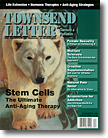National Institutes
of Health scientists have confirmed the concepts that vitamin C is
selectively toxic to cancer cells and that tumor-toxic levels of vitamin
C can be attained using intravenous administration. The article, published
in the September 12, 2005 issue of the Proceedings
of the National Academy of Sciences1 concluded, "These findings give plausibility
to intravenous ascorbic acid in cancer treatment."
 Orthomolecular medical researchers, including Nobel laureate Linus Pauling,
have long recognized the great importance of vitamin C in fighting cancer.2
Scientists associated with the Bio-Communications Research Institute
(BRCI) in Wichita, Kansas have published 20 scientific articles on the
subject.3 BCRI researchers first reported in 1995 that vitamin C in sufficient
amounts is selectively toxic to tumor cells. The authors concluded that
tumor-toxic levels of vitamin C could be achieved only by giving the
vitamin intravenously. Subsequent research from BCRI, published in the
British Journal of Cancer in 2001,4 was the first to describe in detail
the pharmacokinetics of high doses of intravenous vitamin C. Orthomolecular medical researchers, including Nobel laureate Linus Pauling,
have long recognized the great importance of vitamin C in fighting cancer.2
Scientists associated with the Bio-Communications Research Institute
(BRCI) in Wichita, Kansas have published 20 scientific articles on the
subject.3 BCRI researchers first reported in 1995 that vitamin C in sufficient
amounts is selectively toxic to tumor cells. The authors concluded that
tumor-toxic levels of vitamin C could be achieved only by giving the
vitamin intravenously. Subsequent research from BCRI, published in the
British Journal of Cancer in 2001,4 was the first to describe in detail
the pharmacokinetics of high doses of intravenous vitamin C.
"It is gratifying to have our research on vitamin C and cancer confirmed
by scientists at the prestigious National Institutes of Health," said
Neil Riordan, Ph.D., BCRI's Research Director. "The findings
reinforce our goal and commitment to pursue cutting edge cancer research," added
Michael Gonzalez, Ph.D., D.Sc. of the University of Puerto Rico.
BCRI's vitamin C research was headed by its founder, Hugh D. Riordan,
M.D. The research team includes Dr. Xiaolong Meng, Dr. Joseph Casciari,
Dr. Nina Mikirova, Dr. Jie Zhong, Dr. James A. Jackson, Dr. Don Davis,
Dr. Jorge Miranda, Dr. Michael Gonzalez, Dr. Neil Riordan, and Mr. Paul
Taylor.
What is Orthomolecular Medicine?
Linus Pauling defined orthomolecular
medicine as "the treatment
of disease by the provision of the optimum molecular environment, especially
the optimum concentrations of substances normally present in the human
body." Orthomolecular medicine uses safe, effective nutritional
therapy to fight illness. For more information: http://www.orthomolecular.org
Take the Orthomolecular Quiz at http://www.orthomolecular.org/quiz/index.shtml
The peer-reviewed Orthomolecular Medicine News Service is a non-profit
and non-commercial informational resource.
Editorial Review Board:
Abram Hoffer, M.D.
Harold D. Foster, Ph.D.
Bradford Weeks, M.D.
Carolyn Dean, M.D. N.D.
Eric Patterson, M.D.
Thomas Levy, M.D., J.D.
OMNS Editor: Andrew W. Saul, Ph.D. Email: omns@orthomolecular.org .
BCRI contact person: Renee Olmstead: bcri@brightspot.org
To subscribe at no charge: http://orthomolecular.org/subscribe.html

References
1. Chen Q, Espey MG, Krishna MC, Mitchell
JB, Corpe CP, Buettner GR, Shacter E, Levine M. Pharmacologic ascorbic
acid concentrations selectively
kill cancer cells: Action as a pro-drug to deliver hydrogen peroxide
to tissues. Proc Natl Acad Sci USA.
2005 Sep 20;102(38):13604–9.
Epub 2005 Sep 12.
2. Cameron E, Pauling L. Supplemental ascorbate in the supportive treatment
of cancer: Prolongation of survival times in terminal human cancer.
Proc Natl Acad
Sci USA. 1976 Oct;73(10):3685–9. The original paper is posted at http://profiles.nlm.nih.gov/MM/B/B/K/Z/_/mmbbkz.pdf
Also: Cameron E, Pauling L, Leibovitz B. Ascorbic acid and cancer: a review.
Cancer Res. 1979 Mar;39(3):663–81.
3. Full text papers listed and accessible at no charge at http://brightspot.org/cresearch/index.shtml
4. Casciari, J.J., Riordan NH, Schmidt, T.L., Meng, X.L., Jackson JA, Riordan
HD. Cytotoxicity of ascorbate, lipoic acid, and other antioxidants in hollow
fibre in vitro tumours. British J Cancer.
2001, 84(11), 1544–1550.
|





 Orthomolecular medical researchers, including Nobel laureate Linus Pauling,
have long recognized the great importance of vitamin C in fighting cancer.2
Scientists associated with the Bio-Communications Research Institute
(BRCI) in Wichita, Kansas have published 20 scientific articles on the
subject.3 BCRI researchers first reported in 1995 that vitamin C in sufficient
amounts is selectively toxic to tumor cells. The authors concluded that
tumor-toxic levels of vitamin C could be achieved only by giving the
vitamin intravenously. Subsequent research from BCRI, published in the
Orthomolecular medical researchers, including Nobel laureate Linus Pauling,
have long recognized the great importance of vitamin C in fighting cancer.2
Scientists associated with the Bio-Communications Research Institute
(BRCI) in Wichita, Kansas have published 20 scientific articles on the
subject.3 BCRI researchers first reported in 1995 that vitamin C in sufficient
amounts is selectively toxic to tumor cells. The authors concluded that
tumor-toxic levels of vitamin C could be achieved only by giving the
vitamin intravenously. Subsequent research from BCRI, published in the